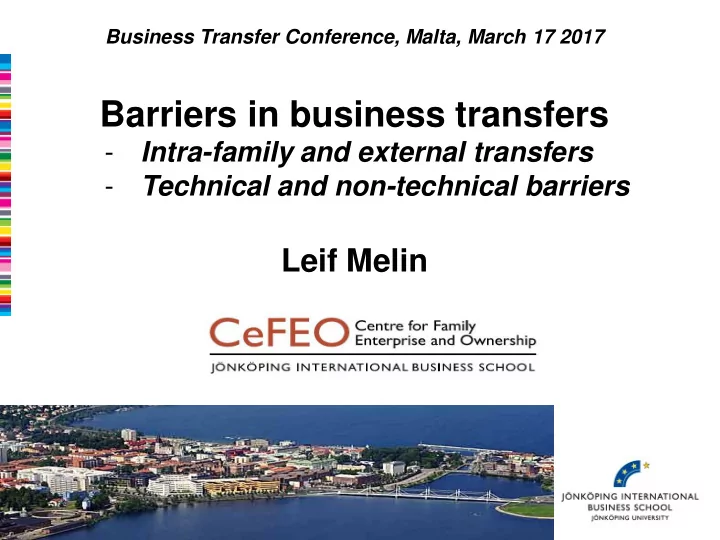

Business Transfer Conference, Malta, March 17 2017 Barriers in business transfers Intra-family and external transfers - Technical and non-technical barriers - Leif Melin
Most likely future owner in order of likeliness 1. Another operating company - Similar size/large corporation 2. Family member(s) - Children, siblings, cousins 3. Employee(s) (or non-family partner) 4. Entrepreneur(s) 5. Investment company 6. Private equity fund 7. Other alternatives And , about 10% are closed down
The heterogeneity of business transfers Different types of transfers imply quite different barriers!! So, there are … …no most critical transfer barrier …no one-best transfer solution The transfer context and situation are crucial for identifying barriers
The logic of family ownership, when selling the family business 5th generation owner and CEO, occupation/safety shoes manufacturer ’ Finding the right buyer is much more important than maximizing the price. I would never sell to our main competitor who would pay more than the bid I have now accepted ’
Likeliness of intra-family vs external transfers • Bigger SMEs - external transfer • Large no of owners - external transfer • Family CEO - intra-family transfer • Next gen 40+ - external transfer • Rural areas - intra-family transfer • Urban areas (big cities) - external transfer • High vs low profitability - more choices vs more complex process
Technical barriers • Tax regulations – Inheritance tax, gift tax, tax on capital gain , … – Big differences across EU • Eg Germany, a complicated inheritance tax, Sweden no inheritance tax, abolished 2004 • Financial issues – Main problem is a dysfunctional market for financing the take over of existing SMEs by new entrepreneurs • Market mismatch – Bad match between potential sellers and buyers – Bad match between incumbent’s needs and available (solution-driven) advisers
Non-technical barriers Incumbent cannot let go 1. Identity crisis: The incumbent’s role after handing over? What do I want to do? And which role could I play? 2. Emotional resistance to leave - Strong attachment with the business 3. Too fun to be an entrepreneur 4. No succession candidate in the family - Lack of motivation and interest from next gen - Lack of ability among next gen; successor not qualified - Successor not trusted - While incumbent don’t want to sell externally
Non-technical barriers (cont.) 5. Incumbent lacking necessary knowledge - on transfer process and critical transfer issues 6. Badly managed transfer process - incl. preparations starting too late 7. Conflicts among present owners Incumbent worried for future consequences 8. Worries for employees after external take over - moving or closing down the business 9. Worries for a destroyed culture after the transfer 10. Worries for strategic functions to disappear
A note on knowledge barriers • Lack of specialized knowledge: a major reason why transfer process is carried out in an unsuccessful manner – Intra-family succession • Understanding emotional, personal, relational issues – External transfer • Specific technical issues in focus (company valuation , DD…) • Shortage of advisers with process knowledge • How to transfer (tacit) knowledge of incumbent to successor, as well as transfer the business network
Some ways to avoid/decrease non-technical problems • Early start of transfer preparations • Work with the transfer as a process, not a transaction event • Prepare and train intra-family successors • Allow successors to take over ’in time ’ • Be prepared on conflicts to resolve • Focus on transfer of business knowledge and social capital to successors
A note on reduced tax barriers • The abolition of gift, inheritance and wealth taxes motivates family businesses to work more actively and purposefully with their transfer • Abolish a tax creates new problems • With no inheritance tax, no pressure to let go in due time • Even if there are no gift, inheritance and wealth taxes, preparation for the ownership transfer is still key • And there are other taxes in play , eg. tax on capital gain when selling the business
Long term consequences of different types of transfer New external owners result in higher growth and EBITDA for the business in the long term Intra-family transfer results in higher survival rates So, what should be favoured in an industrial policy on business transfer?
Growth in EBITA (at the top) and turnover (below) in the generic types of transfer
Conclusions The main barrier is the weak knowledge and understanding of the dynamics of transfer processes among most actors involved - incumbents, successors (next gen), external buyers, brokers, advisors …. - generally, too much focus on technical (legal and financial) aspects of the ownership transfer! - high potential for increased value creation through well performed business transfers Overall, the EU policy recommendations on business transfer ( from 1994, 1998 and 2006) , and the EU expert groups ( from 2000 and 2003) are still very much valid!
Some advice for policy makers • Continously increase awareness among incumbents – It is never to early to start a transfer process! • Foster increased knowledge and understanding of all barriers and problems to be met in transfer processes – applies to all involved actors, incl. academic research • Technical advisors need more insights into the relational and emotional side of transfers • Foster increased availability of capital for financing acquisitions for entrepreneurs buying existing SMEs • Support the use of sellers’ new wealth in the entrepreneurial business system
Finally, the family business, the dominant form of business organization , represent a massive pool of resources for entrepreneurial and innovative initiatives! The succession process in the family business should be further facilitated by policy measures, fostering transgenerational entrepreneurship Thank you! leif.melin@ju.se
Recommend
More recommend